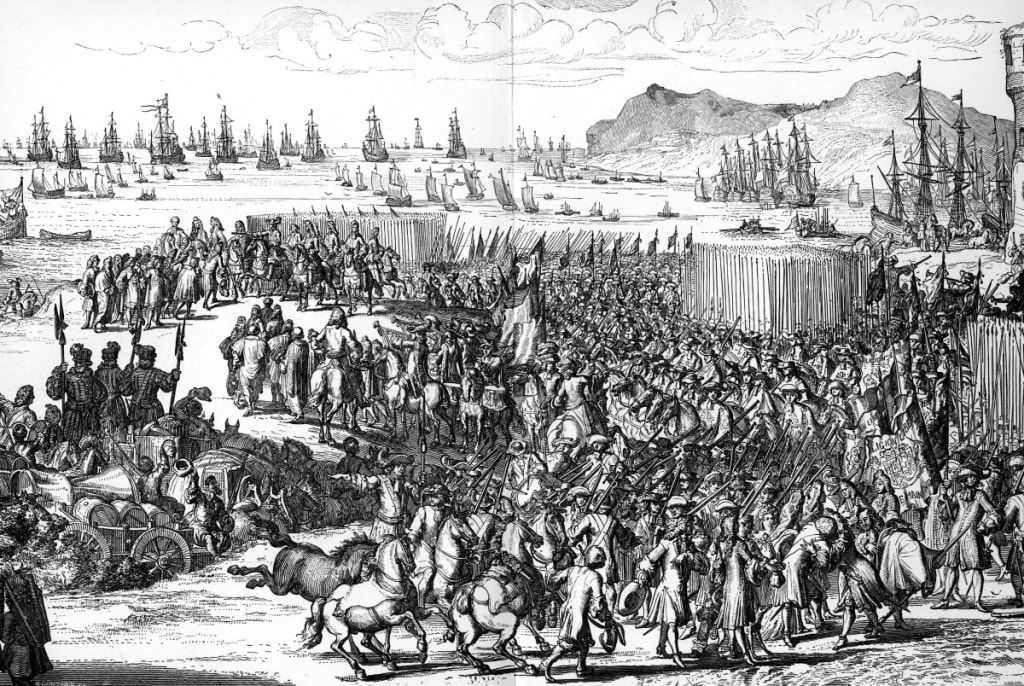Glorious Revolution 1688
Glorious Revolution 1688

The Glorious Revolution was a bloodless coup d 'etat that took place between 1688 and 1689, when Catholic King James II was deposed from England, followed by his Protestant daughter Mary II and the Dutch husband of his Protestant daughter Mary II of Orange, Prince William. III. Fearing the Catholic dictatorship, the revolution replaced the reign of King James I with the same dynasty of Queen Mary II and William III. When Queen Mary gave birth to the son of James II, the people of England were shocked and intimidated by the Catholic heir to the throne.
The Glorious Revolution, which took place between 1688 and 89, was the name used in 1689 by politician John Hampden to see James II of England, Scotland, and Ireland removed by his daughter Mary and her husband, Dutch Prince William III of Orange. William III arrived in England in November 1688 and faced little opposition to the so-called Glorious Revolution.
In 1688, seven of James's peers wrote to Dutch leader William of Orange pledging allegiance to the sons of James Francis and Edward Stuart, who said that they would be taught Catholicism if they invaded England. A major accident caused by a series of Protestant protests in the Anglican camp led seven of his peers to draft June 30, 1688 and promised to support him if he brought troops to England to fight James. Parliament fears that the return of James II and William required England to be ready to support the war with France but the cost would be exorbitant so William intended to lead the military, not a political conflict.
Although William III had been repeatedly called upon to invade England to overthrow King James I, he did not consider it necessary to take any action in defense of the Protestant religion and his position as heir to the throne until the birth of James II. As a young Protestant, William married Mary, the daughter of King James, to obtain an heir. William of Orange, a Dutch Protestant, married Mary Stuart II, daughter of Queen James, but his marriage was rejected by his family who wanted him to marry a French heir to the throne.
The history of the Glorious Revolution begins with the issue of isolation in 1679-83. This was the time of the efforts of the Whigs series and the first Whigs to prevent James, Duke of York, from securing the throne of his brother King Charles II, a delightful king with up to 20 children by several of his owners and his stepchildren. After James' marriage, his wife Mary of Modena gave birth to a son, James Francis Edward Stuart, who pretended to be a minor who feared the formation of a growing Catholic empire.
James Stuart, James the seventh to rule Scotland and the second to rule England, was appointed to be the last Stuart King to sit on the British throne. The actions and birth of his son, James Francis Edward Stuart, brought hope of a long line of Catholics on the throne and was widely attested to by the English.
The Glorious Revolution (1688-1989) established Parliament as the dominant power in England and Britain and transformed it from a monarchy into a constitutional monarch. William's Joint Monarchy, King and Princess Mary have embraced more restrictions on popular parliamentary sessions than ancient kings who created unprecedented changes in the balance of power in the British Empire. Unlike Louis France, the most powerful country in Europe, which remained, either England or the Netherlands were not constitutional kings at the time of the revolution, but republics had a very large population.
The Glen Revolution refers to the events of 1688-89 when King James II of England was deposed and succeeded by one of his daughters or her husband. It was also known as the Sixteenth-century Revolution and the bloodless Revolution in English history, as events led to the removal of James II and the enthronement of his daughter Mary II and her husband William III, Prince of Orange, city governor of the United States. Followers of James Francis Edward Stuart, an impostor trying to reclaim the throne of his father James VII, were arrested during the Reformation.
Mary's daughter Mary was a Protestant and an heir to the throne; in 1688, the son of James Francis Edward Stuart, who had been raised a Catholic, was born.
Powerful politicians contacted Jamess' Dutch nephew and son-in-law William of Orange, whose wife Mary James was the eldest daughter still alive, and invited her to cross the sea with an army to liberate England. This proved to be a boon to William, who hoped to use British resources and power to withstand the onslaught of power-hungry Louis XIV in Europe.





Comments
There are no comments for this story
Be the first to respond and start the conversation.